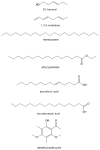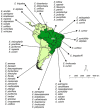Essentials Oils from Brazilian Eugenia and Syzygium Species and Their Biological Activities
- PMID: 32781744
- PMCID: PMC7466042
- DOI: 10.3390/biom10081155
Essentials Oils from Brazilian Eugenia and Syzygium Species and Their Biological Activities
Abstract
The Eugenia and Syzygium genera include approximately 1000 and 1800 species, respectively, and both belong to the Myrtaceae. Their species present economic and medicinal importance and pharmacological properties. Due to their chemical diversity and biological activity, we are reporting the essential oils of 48 species of these two genera, which grow in South America and found mainly in Brazil. Chemically, a total of 127 oil samples have been described and displayed a higher intraspecific and interspecific diversity for both Eugenia spp. and Syzygium spp., according to the site of collection or seasonality. The main volatile compounds were sesquiterpene hydrocarbons and oxygenated sesquiterpenes, mainly with caryophyllane and germacrane skeletons and monoterpenes of mostly the pinane type. The oils presented many biological activities, especially antimicrobial (antifungal and antibacterial), anticholinesterase, anticancer (breast, gastric, melanoma, prostate), antiprotozoal (Leishmania spp.), antioxidant, acaricidal, antinociceptive and anti-inflammatory. These studies can contribute to the rational and economic exploration of Eugenia and Syzygium species once they have been identified as potent natural and alternative sources to the production of new herbal medicines.
Keywords: Eugenia spp; Myrtaceae; Syzygium spp; biological properties; essential oil variability; mono- and sequiterpenes.
Conflict of interest statement
The authors declare no conflict of interest.
Figures







References
-
- Parnell J.A.N., Craven L.A., Biffin E. Matters of Scale: Dealing with One of the Largest Genera of Angiosperms. In: Hodkinson T.R., Parnell J.A.N., editors. Reconstructing the Tree of Life: Taxonomy and Systematics of Species Rich Taxa. Taylor and Francis; Boca Raton, IL, USA: 2007. pp. 251–273.
-
- THE ANGIOSPERM PHYLOGENY GROUP An update of the Angiosperm Phylogeny Group classification for the orders and families of flowering plants: APG IV. Bot. J. Linn. Soc. 2016;181:1–20. doi: 10.1111/boj.12385. - DOI
-
- Mazine F.F., Faria J.E.Q., Giaretta A., Vasconcelos T., Forest F., Lucas E. Phylogeny and biogeography of the hyper-diverse genus Eugenia (Myrtaceae: Myrteae), with emphasis on E. sect. Umbellatae, the most unmanageable clade. TAXON. 2018;67:752–769. doi: 10.12705/674.5. - DOI
-
- Craven L., Biffin E. An infrageneric classification of Syzygium (Myrtaceae) Blumea Biodivers. Evol. Biogeogr. Plants. 2010;55:94–99. doi: 10.3767/000651910X499303. - DOI
-
- Van Der Merwe M.M., Van Wyk A.E.E., Botha A.M. Molecular phylogenetic analysis of Eugenia L. (Myrtaceae), with emphasis on southern African taxa. Plant Syst. Evol. 2004;251:21–34. doi: 10.1007/s00606-004-0160-0. - DOI
Publication types
MeSH terms
Substances
LinkOut - more resources
Full Text Sources
Medical
Miscellaneous

